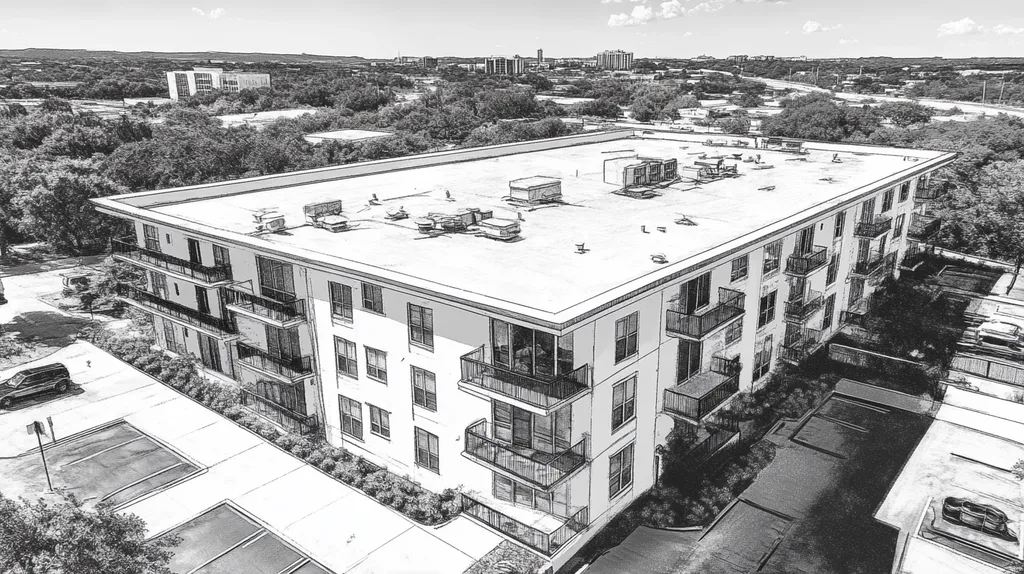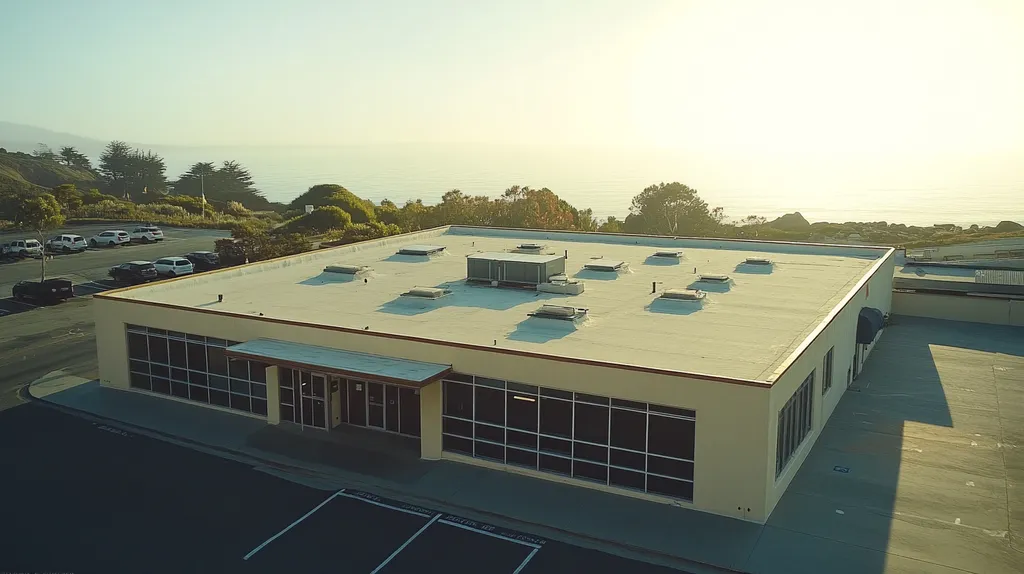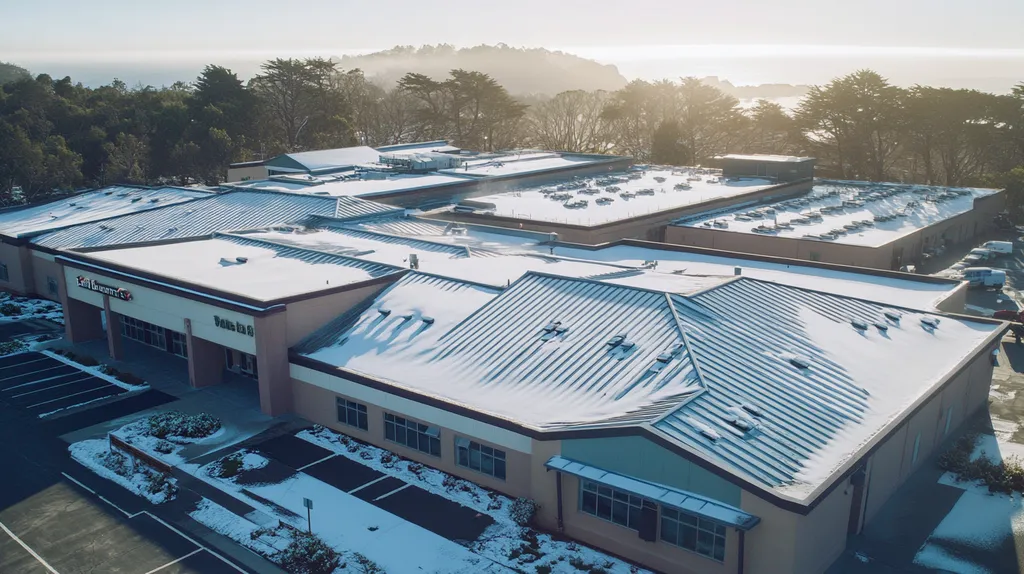Weather-related disruptions cost the commercial roofing industry over $3.5 billion annually in delays and material damage, according to recent industry data. For facility managers, these interruptions can extend project timelines by 20-30% while significantly inflating budgets.
Successfully navigating weather impacts requires a systematic approach across performance, financial, compliance, and operational considerations.
This comprehensive guide equips facility managers with actionable strategies to protect project timelines and budgets from weather-related setbacks while maintaining installation quality and safety standards.
SECTION 1: PERFORMANCE FACTORS
Weather is a decisive element in the success of commercial roofing projects. Inclement weather—ranging from heavy rain and snow to extreme heat—can lead to significant delays and jeopardize the installation quality of roofs. In fact, nearly 30% of roofing projects experience delays due to adverse weather conditions, as reported by the National Roofing Contractors Association. By gaining insights into how performance factors are influenced by these conditions, facility managers can more effectively manage schedules and avert costly complications.
Weather Conditions Affecting Roof Material Integrity
The choice of roofing material plays a pivotal role in how well a roof can endure various weather conditions. For instance, asphalt shingles may curl and deteriorate under excessive heat, while metal roofing can become susceptible to corrosion if inadequately coated. Heavy rainfall can obstruct the installation process, risking improper sealing and increasing the potential for leaks.
Facility managers should carefully assess local climate conditions before selecting roofing materials, ensuring that the options chosen can endure seasonal weather fluctuations. By emphasizing material resilience based on upcoming weather forecasts, facility managers can significantly reduce associated risks.
Additionally, regular roof inspections become vital for identifying and addressing weather-related damage swiftly. Ongoing evaluations help maintain the roof’s structural integrity even as weather conditions evolve.
Key Action Items
Impact of Temperature Extremes on Installation Quality
Temperature extremes can pose significant challenges during roofing installation. High temperatures may cause some roofing materials to become overly pliable, while cold conditions can interfere with proper adhesion. For example, shingles placed in colder weather might not seal correctly. Manufacturers often suggest optimal installation temperatures between 50°F and 85°F; working outside this range can detrimentally affect both installation and long-term roof performance.
To reduce these risks, facility managers should aim to schedule installations within ideal weather windows whenever feasible. Monitoring temperature conditions during the installation process can also facilitate better outcomes, ensuring that roofing crews operate in suitable environments.
Adjusting schedules to account for temperature conditions can significantly enhance installation quality, leading to increased durability and cost savings in the long run.
Key Action Items
Assessing Seasonal Weather Patterns for Project Timing
Understanding seasonal weather patterns is vital for effective scheduling of roofing projects. In areas known for heavy snowfall or rainy seasons, roofing work should be strategically avoided during peak times to prevent unnecessary delays and additional costs. Planning a project during risky weather can lead to setbacks that impact both budget and timeline.
By analyzing historical weather data, facility managers can make educated decisions for project timelines, ensuring that schedules align with favorable weather trends. This foresight not only facilitates better planning but also minimizes the chances of unexpected weather disruptions.
Moreover, adhering to favorable weather conditions can also enhance workforce morale and productivity, as a conducive environment allows for more efficient work. Collaborating with roofing experts familiar with local climate trends can further optimize project planning and scheduling.
Key Action Items
SECTION 2: FINANCIAL CONSIDERATIONS
The financial impact of weather-related delays on commercial roofing projects is significant and often underestimated. Studies show that these disruptions can drive project costs up by as much as 20% or even higher. Facility managers must understand that unexpected weather events not only stall installations but also carry hefty financial consequences. Recognizing these implications is vital for effective project planning and budgeting.
Cost Implications of Weather-Related Project Delays
Delays caused by weather can dramatically inflate overall project costs. Each day that roofing work is halted incurs additional labor costs, equipment rental fees, and potential penalties. For instance, a week’s delay from rain could lead to thousands of dollars in increased labor expenses alone.
Such delays can also disrupt supply chains, resulting in delays for material delivery. If materials are late, their prices may rise due to market shifts, further straining budgets and complicating future financial planning.
Being aware of regional weather patterns is essential for managing these costs. Facilities situated in areas susceptible to extreme weather should approach budgeting with added caution to cushion against potential financial impacts.
Key Action Items
Budgeting for Weather Contingencies and Material Waste
Incorporating weather contingencies into project budgets is not optional; it’s crucial for effective management. Facility managers should plan to set aside an additional 10-15% of the total roofing budget for unexpected weather-related costs. This financial cushion can cover expenses like overages for labor or expedited shipping if weather impacts initial schedules.
Additionally, severe weather can also lead to material waste. Damaging winds or rains can ruin materials left unprotected at the job site, necessitating further purchases that inflate project costs.
To build resilient budgets, facility managers should draw on insights from past projects and look at historical weather data. A forecast-driven approach ensures that projects remain on schedule and within budget.
Key Action Items
Insurance and Weather-Related Claims Management
Having the right insurance is vital to protect against financial loss due to weather impacts on roofing projects. Many facility managers neglect the importance of a strong insurance policy that includes coverage for weather-related damages, which can lead to unexpected financial burdens.
Effective claims management is equally important. Meticulous documentation of weather-related project impacts supports successful claims, while understanding specific policy details about weather-related delays can influence recovery options.
Working with an insurance expert can help identify coverage gaps and ensure claims are filed accurately and promptly following any weather incident. A proactive approach can lead to recovering a substantial portion of costs, helping to alleviate the sting from project delays.
Key Action Items
SECTION 3: COMPLIANCE REQUIREMENTS
Weather conditions can pose serious obstacles for commercial roofing projects, often leading to delays that complicate adherence to local regulations. Facility managers must skillfully navigate building codes, documentation protocols, and environmental rules to manage these challenges effectively. For instance, periods of heavy rain can stall work and require meticulous compliance with safety and legal guidelines. This section emphasizes key compliance areas crucial for facility managers to ensure roofing projects conclude successfully.
Meeting Local Building Codes Amid Weather Constraints
Adhering to local building codes is essential, especially when adverse weather disrupts roofing operations. Many municipalities enforce specific regulations regarding materials and construction practices to enhance building resilience against the elements. For example, roofs in hurricane-prone areas must fulfill stringent wind resistance criteria.
Facility managers should regularly check weather forecasts to anticipate impacts on compliance timelines. Weather-related delays may necessitate extensions for building permits or additional inspections, which can often be secured by engaging constructively with local officials.
Also, plans to postpone or adjust roofing work must align with existing building codes to avoid penalties. Utilizing a compliance checklist based on current weather forecasts aids in remaining proactive, fostering transparency, and building positive relationships with local regulators.
Key Action Items
Documentation and Inspection Protocols During Weather Interruptions
Thorough documentation is crucial during weather-related interruptions in roofing projects. Facility managers need to keep comprehensive records of weather conditions, work schedules, and modifications resulting from adverse weather. This documentation can be indispensable in resolving disputes or claims concerning project delays.
Regular inspections should be conducted to assess work completed before adverse weather events occur. Documenting the condition of materials and structures ensures they comply with safety standards before work resumes. Neglecting inspections may lead to safety breaches or building code issues.
Leveraging digital tools for real-time documentation can optimize the process. Project management apps allow for immediate updates on weather impacts, ensuring all stakeholders stay informed. Clear communication among contractors and inspectors during adverse weather can help maintain alignment with compliance protocols.
Key Action Items
Environmental Regulations for Weather-Influenced Roofing Work
Environmental regulations become especially relevant when weather affects roofing projects. Facility managers must be aware of disposal restrictions or pollution issues that can arise during adverse weather scenarios. Heavy rainfall, for example, may create runoff concerns that necessitate careful management to align with local regulations.
Implementing stormwater management plans is essential during adverse conditions, as these plans ensure compliance with environmental regulations. Adjustments to roofing installation protocols may also be required when anticipating bad weather.
Being mindful of federal and state guidelines regarding emissions from roofing materials is critical, especially when weather necessitates modifications to the original project scope. Consulting with environmental experts during weather-influenced projects can provide crucial guidance to ensure compliance with all relevant regulations.
Key Action Items
SECTION 4: RISK MANAGEMENT
Weather-related disruptions pose significant risks for commercial roofing projects, leading to costly delays and increased expenses. With nearly 30% of construction delays attributed to adverse weather, the need for a robust risk management strategy is critical. Facility managers must proactively identify safety hazards, develop responsive emergency plans, and implement effective measures to mitigate weather-related risks, ensuring both project timelines and budgets remain intact.
Identifying Safety Hazards from Adverse Weather Conditions
Severe weather can introduce multiple safety hazards at roofing sites. Rain can create slippery surfaces, increasing the likelihood of falls, while strong winds may threaten the safety of workers and equipment.
To manage these risks, facility managers should evaluate the specific weather patterns in their region. For example, locations susceptible to thunderstorms need immediate protocols during severe weather alerts.
Utilizing weather-tracking tools can provide timely notifications, enabling teams to prepare for hazardous conditions ahead of time. Furthermore, proper training focused on recognizing these hazards is vital for ensuring workers’ safety.
Conducting regular safety audits can pinpoint vulnerabilities linked to weather conditions. By proactively addressing identified hazards, roofing teams can minimize the risk of accidents and project delays.
Key Action Items
Developing Weather-Responsive Emergency Action Plans
Preparation is essential for minimizing disruptions caused by weather events. A well-structured emergency action plan should clearly outline procedures for various scenarios, such as heavy rain, snow, or high winds.
Facility managers should assign specific roles within their teams to activate these emergency protocols, ensuring rapid response during adverse conditions.
Regular drills will help workers become familiar with emergency procedures, enhancing coordination during actual incidents. The documentation should encompass evacuation routes, emergency contacts, and designated safe areas.
Additionally, continuously updating the action plan is crucial to accommodate changing weather patterns. Collaborating with local meteorologists can provide insights necessary to adjust strategies responsively.
Key Action Items
Mitigating Weather Exposure Risks to Materials and Labor
Weather can significantly impact the structural integrity of roofing materials and the availability of labor. Certain materials may fail under extreme temperatures or high humidity, leading to costly replacements and repairs.
To reduce these risks, facility managers should implement strict storage guidelines to protect materials from adverse conditions, ensuring optimal performance upon installation.
Efficient labor scheduling is equally crucial. Anticipating potential weather disruptions allows teams to adjust work schedules proactively, maximizing labor resources and minimizing downtime.
Incorporating flexible contract terms with roofing contractors can better prepare for unforeseen weather events, enabling seamless navigation through inclement conditions without incurring excessive costs.
Key Action Items
SECTION 5: OPERATIONAL PROCEDURES
Weather unpredictability can derail commercial roofing projects and inflate costs significantly. With 67% of facility managers identifying weather as a prominent factor in project delays, it is crucial to establish strong operational procedures that accommodate these challenges. This section explores scheduling strategies, communication protocols, and quality control measures essential for managing roofing projects in the face of unpredictable weather conditions.
Scheduling Strategies Around Forecasted Weather Events
Proactive scheduling is essential for minimizing weather-related disruptions. Facility managers should frequently consult weather forecasts to anticipate adverse conditions, scheduling critical roofing activities during typically drier seasons to reduce interruptions.
Employing tools such as weather apps or dedicated forecasting services allows project managers to make informed decisions based on real-time data. Alerts for impending storms enable teams to implement preemptive measures like rearranging workdays or securing materials ahead of time.
Additionally, integrating buffer days into project timelines creates a safety margin for delays caused by weather. This strategic planning preserves project momentum and ensures that roofing tasks remain on track, minimizing the risk of water damage.
Key Action Items
Communication Protocols for Weather-Driven Schedule Changes
Clear communication becomes vital when weather conditions necessitate schedule adjustments. Establishing straightforward protocols ensures that all stakeholders, including contractors and suppliers, are promptly informed of changes to the project timeline.
Utilizing a centralized communication platform can streamline updates. For example, project management software with urgent alerts keeps everyone aligned on the latest schedule changes, minimizing confusion and enhancing collaborative decision-making.
Regular meetings to discuss ongoing weather impacts reinforce accountability among team members. This collaborative approach encourages quick problem-solving, fostering a proactive mindset to tackle challenges as they arise.
Key Action Items
Quality Control Measures Under Variable Weather Conditions
Maintaining quality control is crucial, especially during adverse weather. Facility managers must ensure roofing materials are adequately protected during unpredictable conditions. For instance, storing materials indoors or covering them prevents moisture accumulation that can compromise their integrity.
Monitoring installation conditions regularly is just as critical. Setting guidelines for when work should commence or be halted based on temperature or humidity can help prevent severe long-term issues, like leaks or material failures.
Conducting frequent inspections while work is underway ensures issues are identified early. For example, checking for water pooling or improper sealant curing helps mitigate problems brought on by unexpected rainfall.
Key Action Items
SECTION 5: OPERATIONAL PROCEDURES
Weather unpredictability can derail commercial roofing projects and inflate costs significantly. Recent research shows that 67% of facility managers identify weather as a leading factor impacting project timelines. As climate patterns grow more volatile, developing effective operational procedures around these events becomes imperative. This section examines practical scheduling strategies, robust communication protocols, and stringent quality control measures to manage roofing projects during variable weather conditions.
Scheduling Strategies Around Forecasted Weather Events
Proactive scheduling is essential for reducing weather-related disruptions. Facility managers should monitor weather forecasts regularly to anticipate unfavorable conditions. For instance, timing critical roofing tasks during historically drier months diminishes the risk of interruptions.
Using weather apps or specialized forecasting services enables project managers to make data-driven decisions, allowing for instant adjustments to work schedules. Additionally, weather alert systems can provide advance notifications of approaching storms, prompting preemptive actions such as rearranging workdays or securing materials.
Incorporating buffer days within the project timeline also creates a safety net against potential weather delays. This thoughtful planning preserves project momentum and prevents roofing tasks from lingering incomplete, ultimately lowering the risk of water damage.
Key Action Items
Communication Protocols for Weather-Driven Schedule Changes
Effective communication is critical when weather conditions require scheduling changes. Establishing clear protocols ensures that all stakeholders—contractors, suppliers, and internal teams—are promptly updated on the latest timelines.
Utilizing a centralized communication platform can enhance workflows by facilitating swift updates. For example, project management software with urgent alerts helps keep the entire team aligned on schedule modifications, reducing confusion and enhancing collective decision-making.
Regular discussions about ongoing weather impacts reinforce accountability among team members. These meetings promote collaboration, allowing participants to express concerns and jointly develop solutions, fostering a proactive environment that addresses challenges as they arise.
Key Action Items
Quality Control Measures Under Variable Weather Conditions
Maintaining quality control is crucial, particularly during adverse weather. Facility managers must safeguard roofing materials against unpredictable elements. For example, storing materials indoors or covering them with tarps helps prevent moisture absorption that could negatively affect performance.
Consistent monitoring of installation conditions is similarly important. Establishing clear guidelines for when work should proceed or be paused based on temperature or humidity will help avert long-term issues, such as leaks or material failures.
Frequent inspections during ongoing work can identify potential problems early. For example, checking for water pooling or improper sealant curing can help catch setbacks produced by unexpected rain.
Key Action Items
The Bottom Line
Weather-related disruptions cost the commercial roofing industry over $3.5 billion annually, with delays extending project timelines by up to 30% and compromising installation quality.
As climate patterns become increasingly unpredictable, facility managers must prioritize comprehensive weather impact strategies across all aspects of roofing projects.
Success requires systematic approaches to performance monitoring, financial planning, compliance management, risk mitigation, and operational procedures.
Those who implement robust weather management protocols consistently achieve 15-20% better project outcomes in terms of timeline adherence and budget control.
The stakes are clear: weather preparation is no longer optional but essential for protecting both immediate project success and long-term roof performance.
FREQUENTLY ASKED QUESTIONS
Q. How does weather impact commercial roof material integrity?
A. Weather conditions can cause roofing materials to deteriorate or fail. For example, extreme heat can warp asphalt shingles while heavy rain may compromise the sealing of the roof. To avoid damage, assess local climate before material selection and conduct regular inspections.
Q. What are the financial consequences of weather delays for commercial roofs?
A. Weather-related delays can dramatically increase project costs, potentially by up to 20%. Each day of delay incurs additional labor and equipment costs, disrupting supply chains and material deliveries. Thus, budgeting for these contingencies is crucial for effective financial planning.
Q. How can I ensure compliance with roofing regulations during inclement weather?
A. Regularly review local building codes and maintain a compliance checklist. Monitor weather forecasts to anticipate impacts on project timelines for compliance. If delays occur, promptly engage local officials to secure extensions or necessary inspections to remain compliant.
Q. What safety hazards should I consider for roofing projects in bad weather?
A. Bad weather can create slippery surfaces and hazardous conditions. It’s important to train workers on safety protocols regarding adverse weather. Regular safety audits should identify vulnerabilities, keeping everyone informed and prepared for sudden weather changes.
Q. How can I schedule roofing work around weather forecasts effectively?
A. Proactively monitor weather forecasts and schedule critical roofing tasks during historically drier seasons. Utilize weather alert systems for immediate updates, allowing for rapid schedule adjustments. Buffer days in timelines can provide a safety margin against potential delays.
Q. What are effective communication protocols for weather-related schedule changes?
A. Establish clear communication protocols to promptly inform all stakeholders of schedule adjustments. Utilize project management tools for real-time updates and hold regular meetings to discuss ongoing weather impacts, reinforcing accountability and collaborative problem-solving among team members.
Q. How can I protect roofing materials from weather damage?
A. Implement strict storage guidelines to shield roofing materials from adverse weather conditions. Store materials indoors or cover them properly. Regularly monitor installation conditions to prevent severe long-term issues caused by unexpected rain or temperature changes.










